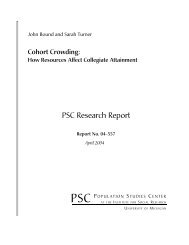Population Ageing and the Well-Being of Older Persons in Thailand ...
Population Ageing and the Well-Being of Older Persons in Thailand ...
Population Ageing and the Well-Being of Older Persons in Thailand ...
Create successful ePaper yourself
Turn your PDF publications into a flip-book with our unique Google optimized e-Paper software.
Section 5: Family support <strong>and</strong> <strong>in</strong>tergenerational exchanges<br />
Figure 5.4 provides <strong>in</strong>formation on who provides care<br />
<strong>and</strong> material support for gr<strong>and</strong>children who live with<br />
<strong>the</strong>ir gr<strong>and</strong>parents but whose parents are absent. In<br />
slightly half <strong>of</strong> <strong>the</strong> cases, a gr<strong>and</strong>parent is <strong>the</strong> ma<strong>in</strong><br />
person caretaker for <strong>the</strong> gr<strong>and</strong>children but <strong>in</strong> only a<br />
relatively small per cent are <strong>the</strong> gr<strong>and</strong>parents <strong>the</strong><br />
primary providers <strong>of</strong> f<strong>in</strong>ancial support for <strong>the</strong> child.<br />
Instead, <strong>the</strong> parents <strong>of</strong> <strong>the</strong> gr<strong>and</strong>child typically take<br />
responsibility for <strong>the</strong>ir children’s f<strong>in</strong>ancial support. A<br />
similar f<strong>in</strong>d<strong>in</strong>g emerged from a recent specialized<br />
survey address<strong>in</strong>g <strong>the</strong> implications <strong>of</strong> migration <strong>of</strong><br />
adult children for <strong>the</strong>ir older age rural parents (Knodel<br />
et al. 2007). This undoubtedly reflects an ability to<br />
send remittances by adult children who migrated<br />
elsewhere to f<strong>in</strong>d employment. In a small number <strong>of</strong><br />
cases gr<strong>and</strong>children take care <strong>of</strong> <strong>and</strong> f<strong>in</strong>ancially<br />
support <strong>the</strong>mselves, presumably reflect<strong>in</strong>g <strong>the</strong> some<br />
are <strong>the</strong>mselves adults.<br />
5.2 Material Support<br />
Children can be important sources <strong>of</strong> economic<br />
support to elderly parents through provid<strong>in</strong>g money,<br />
food, <strong>and</strong> goods. As <strong>in</strong>dicated <strong>in</strong> Section 3, children<br />
frequently are cited as a source <strong>of</strong> <strong>in</strong>come with just<br />
over half <strong>of</strong> all older persons report<strong>in</strong>g that children<br />
are <strong>the</strong>ir ma<strong>in</strong> source <strong>of</strong> current <strong>in</strong>come. Figure 5.5<br />
compares results from 1994 <strong>and</strong> 2007 Surveys <strong>of</strong> <strong>Older</strong><br />
<strong>Persons</strong> <strong>in</strong> Thail<strong>and</strong> with respect to children as a source<br />
<strong>of</strong> <strong>in</strong>come for elderly parents. S<strong>in</strong>ce only those older<br />
persons with liv<strong>in</strong>g children can receive <strong>in</strong>come from<br />
children, results are limited to respondents who have<br />
at least one liv<strong>in</strong>g child.<br />
In both surveys <strong>the</strong> large majority <strong>of</strong> parents reported<br />
that <strong>the</strong>y received <strong>in</strong>come <strong>in</strong> <strong>the</strong> prior year from<br />
children. Also <strong>in</strong> both surveys over half <strong>of</strong> <strong>the</strong> parents<br />
<strong>in</strong>dicated that children were <strong>the</strong>ir ma<strong>in</strong> source <strong>of</strong><br />
<strong>in</strong>come. The per cent who received any <strong>in</strong>come is a<br />
little higher for rural than urban parents but about<br />
<strong>the</strong> same per cent <strong>of</strong> both groups <strong>in</strong> each survey report<br />
children as <strong>the</strong>ir ma<strong>in</strong> source <strong>of</strong> <strong>in</strong>come. Perhaps most<br />
strik<strong>in</strong>g is <strong>the</strong> lack <strong>of</strong> change between <strong>the</strong> two surveys<br />
<strong>in</strong> ei<strong>the</strong>r measure. This contradicts impressions<br />
promoted <strong>in</strong> <strong>the</strong> mass media that “an <strong>in</strong>creas<strong>in</strong>g<br />
number [<strong>of</strong> elderly] do not get support from <strong>the</strong>ir<br />
younger relatives.” (The Nation 2007). 19<br />
47















